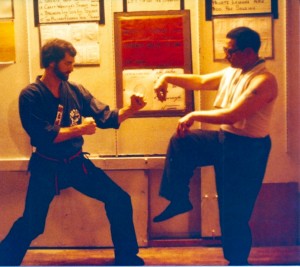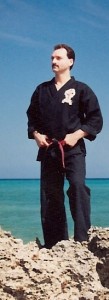MMA – The Good, the Bad, and the Ugly – Part 2
The following article (Part 2 of a 2 part series) was inspired by a number of comments posted by a serious Black Belt instructor who studied with one of my direct students and then expanded the ground aspect of his own MA experience by studying Brazilian Jiu-jitsu. I have slightly modified some of the excerpts from my responding comments in order to share the content of our discussion with our general readers.
This instructor explained the challenges he endured when he attempted to add an MMA program to his curriculum, subsequently resulting in a significant degree of dissatisfaction. You can find his original comments written at the end of my previous article titled, “MMA vs. Tradition – Part 4“.
In these comments submitted by my second generation student, he included the “lessons” he had learned from not so positive experience. Part 2 of this series, written below, is a continuation of my responses and remains in context with his comments.
REFLECTIONS
Many years ago, as a young Sensei and long before the recent MMA popularity, I also made some mistakes similar to those lamented by my student’s student in Part 1 of this series. In a sincere attempt to remove what I mistook for “egoism” from my teaching I began to replace the somewhat formal structure in my dojo and began to run it more like a “coach” in a “gym”.
I became lax with dojo protocol such as exchanging courtesies (bowing, etc.) We called each other by first name and even socialized outside the dojo more like “peers”. It wasn’t until much later that I realized how significantly this began “blurring the lines” separating student and Master teacher, particularly, the responsibility to “set the example” that any strong leader and/or mentor must do and not allow himself to become “one of the boys”. (more…)
MMA – The Good, the Bad, and the Ugly – Part 1
The following article (Part 1 of a 2 part series) was inspired by a number of comments posted by a serious Black Belt instructor who studied with one of my direct students and then expanded the ground aspect of his own MA experience by studying Brazilian Jiu-jitsu. I have slightly modified some of the excerpts from my responding comments order to share the content of our discussion with our general readers.
This instructor explained the challenges he endured when he attempted to add an MMA program to his curriculum, subsequently resulting in a significant degree of dissatisfaction. You can find his original comments written under my previous article titled, “MMA vs. Tradition – Part 4“.
In these comments submitted by my second generation student, he began his discourse using the term “Traditional” when referring to the his use of the USA GoJu system of Martial Arts. My responses began in that context.
What is “Traditional”?
The issue that I would like to point out first is a discrepancy. I am suggesting a more accurate use of the term, “traditional”. First, USA GoJu has been anything but “traditional”. It has been a hybrid system since Grand Master Peter Urban broke from Yamaguchi’s GoJu-Kai in the early 60’s. Remember that he studied under three very accomplished Masters, Richard Kim (Okinawan Shorinji-Ryu Kempo), Gogen Yamaguchi (Japanese Goju-ryu). and Masatatsu Oyama (Kyokushin, which included elements of Shotokan, GoJu-ryu, and Thai boxing).
In reality, the MA taught by GM Urban was a hybrid system. It was based on the primary and foundational concepts, principles, and kata of GoJu-ryu, yet included pertinent elements that he learned from GM Kim and GM Oyama. In addition, GM Urban was very innovative, adding his own unique flair, some that came from his own creative mind and much that resulted from some very practical research and study.
The 1st MMA
The above description is the heritage of what some presently call, USA GoJu. It was arguably one of the first real “Mixed Martial Arts” in the USA. The most profound difference, however, was this system was truly taught as a Martial “ART”, not simply a conglomeration of Martial “TECHNIQUES”. (more…)
MMA vs Tradition – Part 4
This is “Part 4” and final article in the series titled, “MMA vs Tradition”, examining the contrast between the recently popular Mixed Martial Arts (MMA) phenomenon and Traditional Martial Arts. I hope this series has been stimulating and enlightening. Please leave a comment giving your feedback, questions, or opinions. I look forward to continued discussions.
PERSONAL VALUES
And last, there is always the risk in any martial arts training that the “Master”, “trainer”, or “coach” will develop individuals with functional physical skills but without the value system that must rightly be followed if the practitioner is to “survive” in society after any potential physical confrontation. Remember that in a civilized society, there are legal and social repercussions after a physical confrontation.
MMA vs Tradition – Part 3
This is “Part 3” in the series of articles titled “MMA vs Tradition” examining the contrast between the recently popular Mixed Martial Arts (MMA) phenomenon and Traditional Martial Arts. A new section of this article will be posted every Monday. Please leave a comment giving your feedback, questions, or opinions. I look forward to the discussions.
TRADITIONAL APPROACH
This term, “martial arts” has been associated more consistently with eastern traditions than with western science. As I have observed and participated in many of these transitions and activities involving martial arts over most of my lifetime, I have come to the conclusion that there is no “fully traditional” form of martial arts. Instead we have varying degrees of one or the other.
To one extreme are practitioners who are dedicated to a method that is practiced as close to its original form as they are aware. At the other extreme are those who believe in the practice of taking any and/or all techniques, methods, or strategies they have access to and mixing it all together to gain a more “realistic” application.
Like I quoted previously; “It’s all good”. However, while stating that I must add a caveat that each of these approaches can also have their drawbacks and failings.
MMA vs Tradition – Part 2
This is “Part 2” in the series of articles titled “MMA vs Tradition” examining the contrast between the recently popular Mixed Martial Arts (MMA) phenomenon and Traditional Martial Arts. A new section of this article will be posted every Monday. Please leave a comment giving your feedback, questions, or opinions. I look forward to the discussions.
BALANCE FOR THE PRACTITIONER
Many societies and/or philosophical systems have come to a similar conclusion. This conclusion is that humans function most efficiently when they achieve some type of balance and integration between the complex aspects of each individual. Conceptually, we can isolate the physical, the intellectual, the emotional, and the spiritual into separate concepts and areas of development. However, in reality they are never truly separate or isolated and all interact to influence the performance of any individual.
Recognize that even the term “art” denotes a form of personal expression. Any “art” is a type of expression that innately reveals the inner self, its underlying values, and creatively projects to what point that person has arrived relative to his journey in life. Hence, true “martial arts” carries with it a potentially more versatile activity than simple “martial science” or “martial technique”.
MMA vs Tradition – Part 1
This begins a series of articles titled, “MMA vs Tradition”, examining the contrast between the recently popular Mixed Martial Arts (MMA) phenomenon and Traditional Martial Arts. A new section adding to this article will be posted each Monday.
INTRODUCTION
Martial Arts have been in existence before even the earliest written history of human civilization. It may be noted that the first time a human had to ball up his fist to defend himself or his loved ones, or to grab, push or shove another, or to find some way to survive against various predators, animal and/or human, this created a valid need for such activity.



